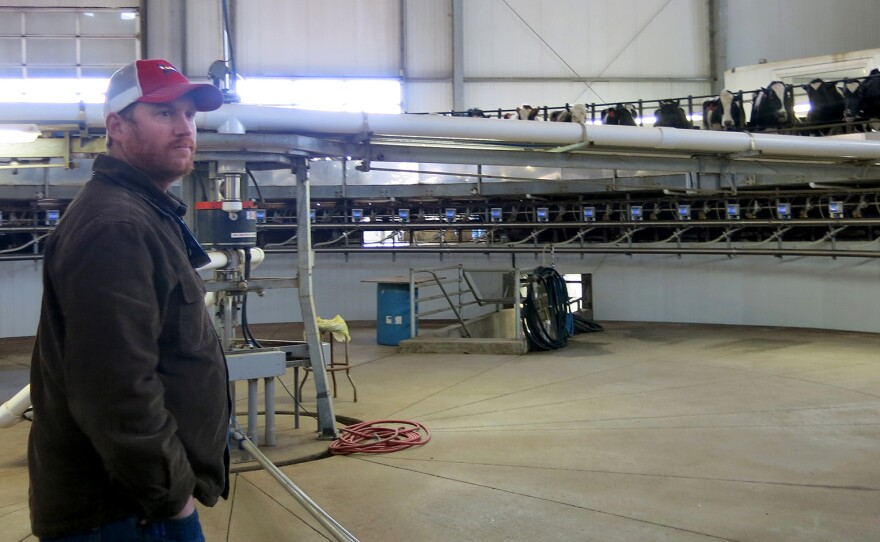
The population of northern Colorado is booming, and we're not just talking about people here.
The number of dairy cows is now higher than ever.
At the northern edge of the state, Weld and Larimer counties are already home to high numbers of beef and dairy cattle, buttressed by the region's numerous feedlots, which send the animals to several nearby slaughterhouses. But an expansion of a cheese factory owned by dairy giant Leprino Foods will require even more cows.
When a big food company builds a factory, it does more than just bring in new industry. Farmers change what they grow, expand their herds and buy new land. When a new meatpacking plant or dairy company rolls into town, it can quite literally change the landscape around it.
Leprino's cheese is ubiquitous. You've likely eaten their cheese without even realizing it — the company sells wholesale to other brands. Leprino cheese is sprinkled on everything from Papa John's pizza to all manner of frozen dinners. The whey that's created as a byproduct of the cheese-making processes is sold as protein powder.
"There's a good chance that if you go buy a bag of shredded mozzarella in the grocery store, that it's our cheese," says Leprino executive Mike Reidy. The privately held company, based in Denver, is the largest mozzarella manufacturer in the world.
And to make all that cheese and whey, Leprino needs a ton of milk. Already, its Greeley, Colo., plant, which started operations in 2011, takes in more than 5 million pounds of milk a day. Now that Leprino is expanding, Colorado dairy farmers are beefing up their operations.
"Generally the number we've been sharing with folks is about an incremental 30,000 cows," Reidy says. "It's a lot."
Casey DeHaan's dairy farm near Ault, Colo., is one of many that will be expanding to meet Leprino's demand for milk. The farm looks pretty standard from the county road it sits on — there's a big red barn and a few pens full of cows.
DeHaan has been up and running here for eight years, after moving to Colorado from his home state of California. When Leprino first announced it was setting up shop in nearby Greeley, DeHaan's began adding more cows, even bringing in some from other states to meeting the growing demand. "We went from 3,000 cows to 4,000 cows," DeHaan says.
Leprino's northern Colorado facility takes in nearly all the milk DeHaan's cows churn out, plus the milk produced at his brother's farm nearby and much of the milk his neighboring dairy farmers produce. If you're a large-scale dairy farmer in Colorado's Weld, Larimer or Morgan counties, there's a good chance that you're shipping your milk to Leprino.
The new cheese factory has transformed this once relatively modest dairy region. In less than 20 years, from 1997 to 2015, the number of dairy cows in the area has more than doubled.
And Tom Haren, CEO of Ag Professionals, a consulting group in northern Colorado that helps farmers expand their operations, helped make that growth happen. In the mid-2000s, his team worked with Dairy Farmers of America, the co-op that purchases milk for Leprino, to assess the area's potential to be a thriving "milk shed," a place capable of churning out vast volumes of milk.
When a company is thinking about an expansion, they ask a series of questions, Haren says: "Does it have the water? Does it have the land? The regulatory environment? The political will? The interest in the farmers and the people? Does it have a market?"
In northern Colorado, Haren says, the answers were mostly positive.
Most new dairies in Colorado are popping up within an 80-mile radius of the expanding Leprino plant, Haren says. Because milk can spoil quickly and shipping it in big refrigerated trucks is expensive, dairy farmers want to be close to the companies who are buying their milk and the people in cities who drink it.
"We're dealing in agriculture, particularly with milk, with a perishable commodity," Haren says. "How long can you sit on it before it becomes something unusable?"
In many ways, our food system is regional. Big cattle feedlots stake a claim near companies that produce hamburger meat, and large hog barns near bacon factories. Across the rural areas that produce food crops, you'll find farms clustered around the factories that process their products and processors moving close to their suppliers.
The changes in industry in a region, however, don't come without costs.
The growing dairy hub in Colorado is also seeing dramatic population growth. Water is limited. Many of the new and expanding dairies are finding themselves positioned near or within suburban communities, notes Casey DeHaan. He can see some of those rapidly growing neighborhoods from his dairy farm.
When he was designing his operation, he tried hard to cut down on odors from manure and muddy pens. DeHaan says he's trying to find a balance between being close to cities, to cut down on shipping costs and to secure a labor force, without being a nuisance.
"Eight million pounds of milk a day? They're knocking on the door now wanting to get to that point," DeHaan says. "I think the Colorado dairymen will do everything they can to help make that happen for them."
Luke Runyon reports for Harvest Public Media and is based at member station KUNC in Greeley, Colo.
Copyright 2016 KUNC-FM. To see more, visit KUNC-FM.






